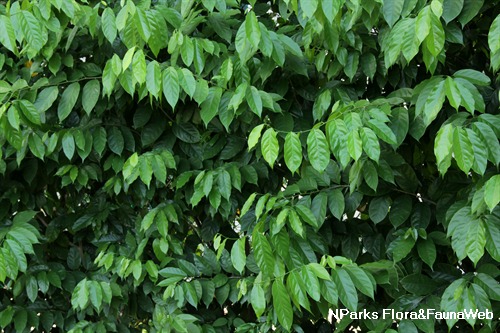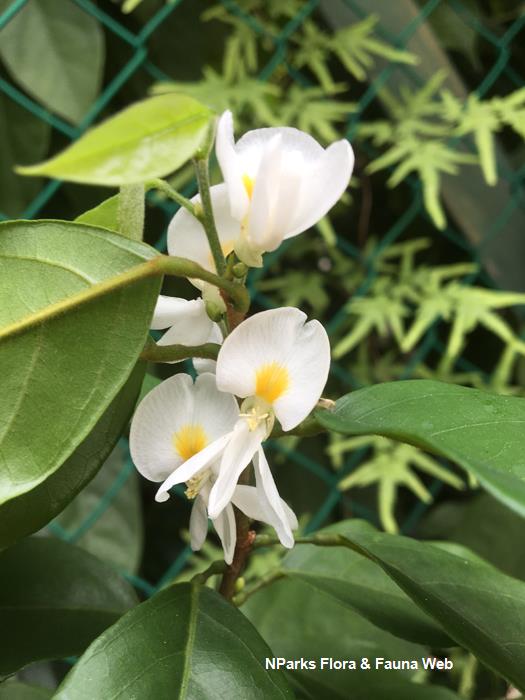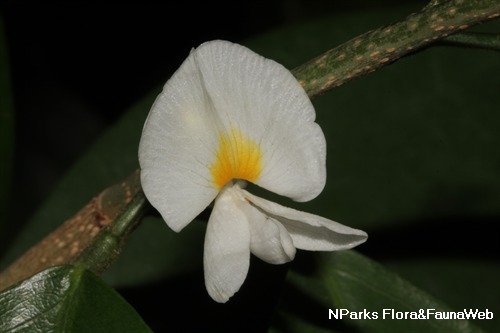
Back
Baphia nitida Lodd.
| Family Name: | Fabaceae (Leguminosae) |
| Common Name: | Camwood, African Sandlewood, Barwood |
Baphia nitida, which is commonly known as Camwood is a shrub that is commonly cultivated as hedge especially around schools. It has glossy dark green leaves and attractive white pea-like flowers.
Name
Classifications and Characteristics
| Plant Division | Angiosperms (Flowering Seed Plants) (Dicotyledon) |
|---|---|
| Plant Growth Form | Shrub |
| Lifespan (in Singapore) | Perennial |
| Mode of Nutrition | Autotrophic |
| Plant Shape | Open |
| Maximum Height | 3 m to 10 m |
Biogeography
| Native Distribution | Tropical Africa |
|---|---|
| Native Habitat | Terrestrial |
| Preferred Climate Zone | Tropical, Sub-Tropical / Monsoonal |
| Local Conservation Status | Non-native (Spontaneous (Casual)) |
Description and Ethnobotany
| Growth Form | Small to medium sized shrub, about to grow up to about 4 - 5 m tall. |
|---|---|
| Foliage | Smooth, green leaves are oval-shaped, measuring about 10 - 15 cm long. |
| Flowers | Flowers white, pea-like and fragrant, having a bright yellow centre. |
| Fruit | Fruits are pods, usually contains 2 - 4 brown, flat seeds. |
| Cultivation | In Singapore, this species is often grown as a hedge around schools. |
| Etymology | Genus Baphia refers to using the heartwood of the plant to extract a red dye. Species nitida refers to the wood having a polished surface. |
| Ethnobotanical Uses | Timber & Products: A red or reddish brown dye can be extracted from the heartwood. In Singapore, the wood was once commonly used to make walking sticks. |
Landscaping Features
| Landscaping | Ideal as hedges for screening purpose. |
|---|---|
| Desirable Plant Features | Fragrant (Flowers) |
| Landscape Uses | Hedge / Screening |
Plant Care and Propagation
| Light Preference | Full Sun |
|---|---|
| Water Preference | Moderate Water |
| Plant Growth Rate | Moderate |
| Propagation Method | Stem Cutting |
Foliar
| Foliage Retention | Evergreen |
|---|---|
| Mature Foliage Colour(s) | Green |
| Mature Foliage Texture(s) | Smooth |
| Prominent Young Flush Colour(s) | Green |
| Young Flush Texture(s) | Smooth |
| Foliar Type | Simple / Unifoliate |
| Foliar Arrangement Along Stem | Alternate |
| Foliar Attachment to Stem | Petiolate |
| Foliar Shape(s) | Non-Palm Foliage (Oval) |
| Foliar Venation | Pinnate / Net |
| Foliar Margin | Entire |
| Foliar Apex - Tip | Acute |
| Foliar Base | Acute, Rounded / Obtuse |
| Leaf Area Index (LAI) for Green Plot Ratio | 4.5 (Shrub & Groundcover - Dicot) |
Floral (Angiosperm)
| Flower & Plant Sexuality | Bisexual Flowers |
| Flower Colour(s) | White |
|---|---|
| Flower Texture(s) | Smooth |
| Flower Grouping | Cluster / Inflorescence |
| Flower Location | Axillary |
| Flower Symmetry | Bilateral |
| Individual Flower Shape | Papilionaceous / Pea-shaped |
| Flowering Habit | Polycarpic |
References
| References | Science Club River Valley High School. 1991. A Guide to the Flora and Fauna of Schools in Singapore. Singapore: Hillview Publications. 169 |
|---|
Image Repository
Others
| Master ID | 421 |
|---|---|
| Species ID | 1717 |
| Flora Disclaimer | The information in this website has been compiled from reliable sources, such as reference works on medicinal plants. It is not a substitute for medical advice or treatment and NParks does not purport to provide any medical advice. Readers should always consult his/her physician before using or consuming a plant for medicinal purposes. |


